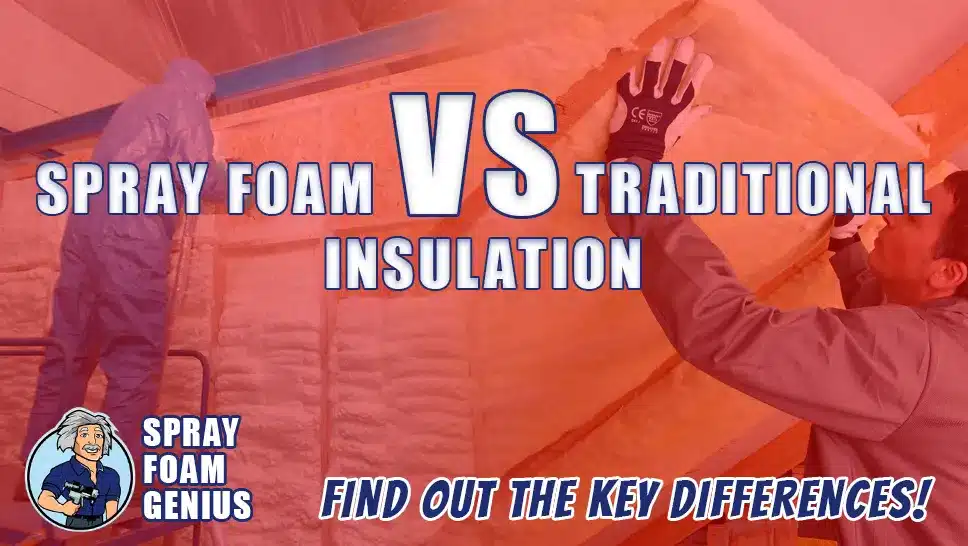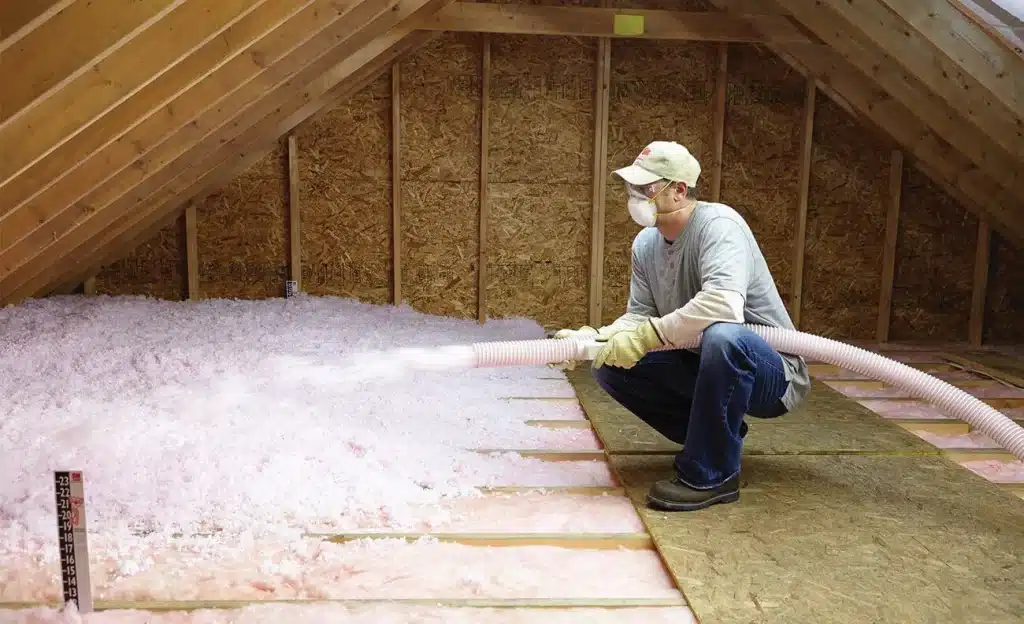
Insulating your home is one of the most important decisions you can make to improve energy efficiency, comfort, and overall home value. With various insulation options available, homeowners often face the dilemma of choosing between modern spray foam insulation and traditional insulation methods such as fiberglass and cellulose.
At Spray Foam Genius Marketing, we specialize in helping spray foam insulation contractors market their services effectively. However, we also understand the importance of educating homeowners about their options. In this blog, we’ll compare spray foam insulation with traditional insulation to help you determine which is the best choice for your home.
Understanding Spray Foam Insulation
Spray foam insulation is a cutting-edge insulation material that is applied as a liquid, expanding into a thick foam that seals gaps and insulates effectively. It comes in two primary types: open-cell and closed-cell.
Types of Spray Foam Insulation
- Open-Cell Spray Foam: This type of spray foam is less dense and more flexible, with an R-value (a measure of thermal resistance) of about 3.5 to 3.6 per inch. Open-cell foam is ideal for soundproofing and insulating interior walls.
- Closed-Cell Spray Foam: Closed-cell foam is denser and provides a higher R-value of approximately 6 to 7 per inch. It offers superior insulation and acts as a moisture barrier, making it ideal for exterior applications.
Advantages of Spray Foam Insulation
- Superior Air Sealing: Spray foam expands to fill gaps, creating an airtight seal that significantly reduces energy loss.
- High R-Value: Closed-cell spray foam offers one of the highest R-values per inch, making it exceptionally effective in preventing heat transfer.
- Moisture Barrier: Closed-cell spray foam acts as a moisture barrier, helping to prevent mold and mildew.
- Durability: Once applied, spray foam insulation is highly durable, often lasting the lifetime of the building.
- Soundproofing: Open-cell spray foam is particularly effective at reducing noise transmission.
Disadvantages of Spray Foam Insulation
- Higher Initial Cost: Spray foam insulation typically costs more upfront compared to traditional insulation.
- Professional Installation Required: Proper installation of spray foam requires trained professionals.
- Potential Over-Expansion: If not applied correctly, spray foam can over-expand, potentially damaging walls or other structures.
Understanding Traditional Insulation

Traditional insulation methods have been used for decades and include materials such as fiberglass, cellulose, and rigid foam boards. Each type has unique characteristics that can influence your decision.
Types of Traditional Insulation
- Fiberglass Insulation: Made from fine glass fibers, fiberglass is available in batts, rolls, and loose-fill forms and is commonly used in walls, attics, and floors.
- Cellulose Insulation: Made from recycled paper products and treated with fire retardants, cellulose is typically blown into walls and attics.
- Rigid Foam Boards: These boards are made from materials like polystyrene and polyisocyanurate and are used in walls, roofs, and foundations.
Advantages of Traditional Insulation
- Lower Initial Cost: Traditional insulation materials, particularly fiberglass and cellulose, are generally more affordable.
- DIY-Friendly: Many traditional insulation types can be installed by homeowners, saving on installation costs.
- Widely Available: Traditional insulation materials are easily accessible and come in various forms.
Disadvantages of Traditional Insulation
- Lower R-Value: Most traditional insulation materials have a lower R-value per inch compared to spray foam.
- Air Leaks: Traditional insulation often does not provide a complete air seal, which can lead to drafts and energy loss.
- Moisture Sensitivity: Materials like fiberglass and cellulose can absorb moisture, potentially leading to mold growth.
- Degradation Over Time: Traditional insulation can settle or compress over time, reducing its effectiveness.
Key Comparison Factors
1. Energy Efficiency
- Spray Foam Insulation: Closed-cell spray foam has a high R-value of about 6 to 7 per inch, offering superior energy efficiency. Its ability to create an airtight seal further enhances energy savings.
- Traditional Insulation: Fiberglass typically has an R-value of 2.2 to 3.8 per inch, while cellulose ranges from 3.2 to 3.8 per inch. While effective, these materials do not provide the same level of air sealing, potentially leading to higher energy costs over time.
2. Installation Process
- Spray Foam Insulation: Requires professional installation due to the specialized equipment and expertise needed. The process involves spraying a liquid that expands into foam, filling gaps, and ensuring a comprehensive air seal.
- Traditional Insulation: Easier to install, with options like fiberglass batts being DIY-friendly. However, blown-in cellulose and rigid foam boards may still require professional installation.
3. Cost Considerations
- Spray Foam Insulation: Higher initial costs due to the material and professional installation. However, the energy savings over time can offset these upfront costs.
- Traditional Insulation: More affordable initially, especially if you install it yourself. However, lower energy efficiency and the potential for degradation can lead to higher long-term costs.
4. Longevity and Durability
- Spray Foam Insulation: Highly durable and resistant to settling or shifting, maintaining its effectiveness for decades.
- Traditional Insulation: Prone to settling, compression, and moisture damage, which can reduce its insulating properties over time.
5. Environmental Impact
- Spray Foam Insulation: Made from petroleum-based chemicals, spray foam may have a larger environmental footprint. However, its energy-saving capabilities contribute to lower overall carbon emissions.
- Traditional Insulation: Cellulose insulation is environmentally friendly due to its recycled content. Fiberglass also has a relatively low environmental impact, but both can have drawbacks in production and disposal.
6. Health and Safety
- Spray Foam Insulation: When installed correctly, spray foam can improve indoor air quality by reducing drafts and preventing pollutants from entering. However, proper handling is essential to avoid exposure to the chemicals during application.
- Traditional Insulation: Fiberglass can release particles that may be harmful if inhaled, while cellulose treated with fire retardants could off-gas. Proper installation and handling are crucial to minimizing health risks.
Application Scenarios: Which Insulation is Right for You?
New Construction
- Spray Foam Insulation: Ideal for new builds, especially where energy efficiency and air sealing are priorities. Suitable for areas with extreme temperatures or moisture issues.
- Traditional Insulation: Cost-effective for new construction projects, particularly if budget constraints are a concern. Suitable for use in combination with air sealing techniques.
Retrofits and Renovations
- Spray Foam Insulation: Excellent for retrofitting older homes with poor insulation. It can be sprayed into existing walls, enhancing energy efficiency without extensive demolition.
- Traditional Insulation: Blown-in cellulose can be an effective and affordable option for insulating existing walls, particularly during renovations.
Attics and Roofs
- Spray Foam Insulation: Best for attics and roofs where air leaks and moisture issues are common. Closed-cell spray foam provides a strong barrier against both air and water infiltration.
- Traditional Insulation: Fiberglass batts are commonly used in attics, but they may not offer the same air-sealing benefits as spray foam.
Making the Right Choice
Deciding between spray foam insulation and traditional insulation ultimately depends on your specific needs, budget, and priorities.
- Spray Foam Insulation offers superior energy efficiency, air sealing, and long-term durability, making it an excellent investment for homeowners who prioritize energy savings and comfort. While the initial cost is higher, the benefits often outweigh the upfront expense.
- Traditional Insulation may be more affordable upfront, especially for DIY installations. However, its lower R-value and potential for air leaks could result in higher energy bills and the need for future upgrades.
At Spray Foam Genius Marketing, we’re here to help you make an informed decision. Whether you’re leaning towards spray foam or traditional insulation, our team can connect you with trusted insulation contractors who can provide expert advice and professional installation services.Ready to enhance your home’s comfort and energy efficiency? Call us at 877-840-FOAM for USA and 844-741-FOAM for Canada visit our website at sprayfoamgeniusmarketing.com, or email us at [email protected] to get started. Let’s work together to find the best insulation solution for your home.
- Social Media Marketing for Spray Foam Businesses: What Works in 2025? - February 6, 2025
- Best SEO Strategies for Spray Foam Insulation Contractors to Rank #1 on Google - February 6, 2025
- What is Spray Foam Insulation? Benefits and Applications - February 5, 2025

